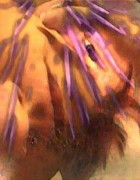 And a quick nod, too…
And a quick nod, too…
Whether referenced by name or not, many of Carl Jung’s concepts quietly prevail among artists of all stripes. From the atheists to the spiritualists, the pragmatists and the mystics, even among the more politically conservative and radical artists I’ve worked with… Jung’s surrender to the magical holds sway. He spoke to the less-than-rational experiences and observations we have of ourselves.
Granted, his theoretical explanations are not roundly accepted, if understood, and the creative affiliation is as much due simply to common interests. Exploring the illogical, mysterious, emblematic, symbolic, representative, and archetypal as it relates to the minutiae of human drama is the mutual realm of intrigue. Especially with regard to poetry and performance creation. It was through his own intrigues with ancient ritual and artifacts, as well as his forays into art-making, that Jung developed his views on personality types and transcendent archetypes of the collective un/consciousness.
In the discipline of psychology, many of Jung’s intangibles were put aside in favour of Freud’s variously oedipal themes. Apparently, the latter more resonated with the academia of Late Modern times. In any case, there were convergences in psychoanalytic theory to which both did agree.
As a child, I spent a lot of time at libraries sniffing around for anything esoteric. Myth, monsters, deities, ghosts, witches, divination, and dreams. Bags full of books for every trip I made. I was nine or ten years old, when I happened upon Jung and Freud. I had no inkling of, nor interest in, their reputations. I don’t recall ever so much as registering this word “psychoanalysis”. More specifically, at that time, I was determined to understand my dreams.
 And so I did. Or, at least, I thought I did. In hindsight, I achieved something elsewise essential; I became adept at recalling more of my dreams. A skill that has rather withered away with time, and lack of effort, of course. Nonetheless, I still have access to and benefit from the memories. Of course, new insights are garnered with more life experience.
And so I did. Or, at least, I thought I did. In hindsight, I achieved something elsewise essential; I became adept at recalling more of my dreams. A skill that has rather withered away with time, and lack of effort, of course. Nonetheless, I still have access to and benefit from the memories. Of course, new insights are garnered with more life experience.
In my teens, I met with artists exploring similar themes; how to evoke the stuff of dreams. To reference and work with our own myths and to explore the meanings in the performance of ritual. It was a few years down the road yet, before I understood the many other interests I shared with artist’s of the Surrealist and Absurdist movements of the past. It wasn’t until my late-twenties, that I really sat down to acquaint my adult self with Freud and Jung.
What occurred to me then, remains with me today: Their works should be taken less as rigid guidelines and more as examples of how one or another individual explores, understands, conceives and justifies their own worldview. They offered up their own psyches – and their own character of interpretation of other people’s psyches – from which we have borrowed and built upon ever since. Their varying insights have furnished ours as greatly as any of the best known philosophers.
That said and acknowledged; I’ve never really been a big fan of Freud. Perhaps most of all because the predominance of his Word still lingers on. Whereas, with Jung… Well, I suspect there is much of value in his body of work to be revisited afresh.
More on that, later. For now, some leisurely backgrounders on Jung himself:
BBC Face to Face: Carl Gustav Jung (1959) with John Freeman. Three part short video playlist from the CosmoLearning site, but here is the YouTube location for mobile users.
Mark Vernon chairs a discussion with two leading experts on Jung, each offering a different perspective: Robert Rowland-Smith, philosopher, consultant, columnist and author and Gary Lachman; author of Jung The Mystic and bass-player and composer in a band called Blondie. (Switch to YouTube)
Three one hour segments from PBS: Carl Jung The Wisdom of The Dream (Switch to YouTube).
[Photo Credits: Wikipedia, C.G. Jung]

